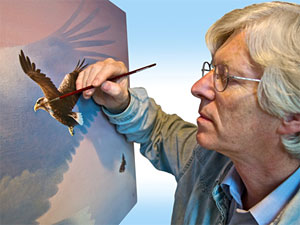


Tjerk Zijlstra was born in 1947 in Koog aan de Zaan. From 1966 to 1971 he went to the Gerrit Rietveld Academy in Amsterdam and graduated as a graphic designer and painter. The painting lessons that he got there were given by teachers including Melle and Herman Gordijn. Besides his work as a graphic designer, and later as a project manager in ICT, he has always painted. In 2007 he stopped working in ICT, to focus entirely on painting and graphic design.
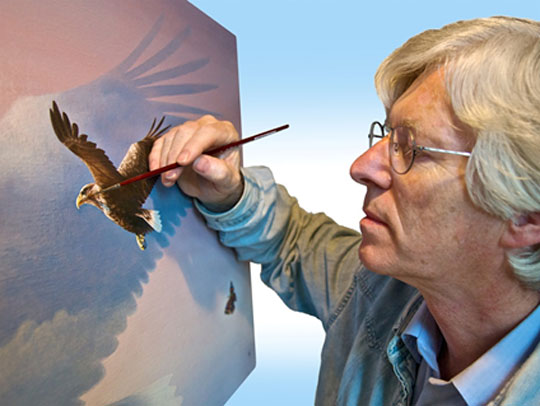
As a painter Tjerk can be best described as a surrealist. He is an artist who loves a bright colouring and prefers to paint with oils. In his paintings he is inspired by chess. Over the years chess has become more than just a game for him. It's not just a sport that is practiced both by professionals and amateurs, but it also symbolizes mankind itself. And that gives it a special fascination. It was a revelation to see that both in chess as in the Zen philosophy there is the same core. This theme he has used previously in the "Prenten van de os" ("Prints of the ox"), a ten-part series of paintings based on the eponymous Zen story. The goal is to finally discover your true self. For him this is also what is chess about.
The paintings are characterized by a symbolic or a realistic depiction of chess positions, chess problems and surprising chess anecdotes. The following symbolism of chess Tjerk uses in his paintings:
The chessboard consists of 64 squares of alternating black and white and it is the floor of the "House of Mysteries." Both on the board and in the spiritual world the pieces move according to a fixed law. Over centuries there rages the struggle between good and evil, light and dark, black and white. Each piece has its own meaning: the king in the game symbolizes the spirit, the queen symbolizes the mind, the rook symbolizes the physical body, the knight symbolizes the force, the bishop symbolizes the feeling and the pawns symbolize the senses. The white pieces symbolize the higher self and its supporters, the black pieces the lower self, the ego, and its followers. Chess thus shows us the eternal struggle of mankind with every part of his complex nature against the downside of it.
There follow some paintings by Tjerk, with his descriptions. Also visit his website www.tjerkzijlstra.nl.

"A fait accompli", 80x80 cm oil on canvas; 2014
The Lewis Chessmen set the stage for a smothered mate. The Lewis Chessmen is a group of 93 chess pieces from the 12th century, carved in ivory from walrus and whale teeth, which were found in 1831 on the Isle of Lewis in the Hebrides, Scotland. The meaning of the various pieces was difficult to unravel and so there are different interpretations. Tjerk uses replicas of the Lewis Chessmen for his paintings. The originals are in the British Museum in London, where the rook is depicted as a warrior, called the watchman. Tjerk's grandson Quinn stood model for the cherub that sends the queen from the spiritual world.
The position depicted in the painting is from the following:
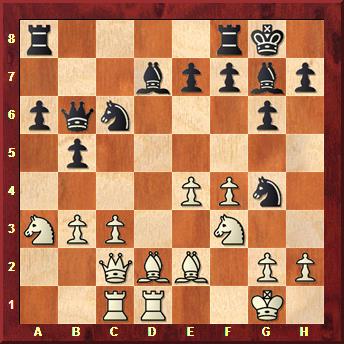
The continuation is 1.Kh1 Nf2+ 2.Kg1 Nh3+ 3.Kh1 Qg1+ 4.Rxg1 Nf2 smothered mate!

"From mind to spirit through the 4th Dimension", 70x100 cm oil; 2014
From an early age my father explained me how to look from the first dimension to the second, and then to the third dimension, and, using reasoning, to the fourth dimension. It then struck me enormously, and still does. The human eye can’t see the fourth dimension yet, just like the spiritual world. Perhaps the fourth dimension is equal to the spiritual world. The eyes of birds of prey, in this case the sparrowhawk, see a lot more than we do, but what they exactly see we do not know. The metamorphosis of the mind to the spirit goes from the queen to the king. The tesseract is made up of eight three-dimensionel cubes painted in two dimensions, which makes it complicated and difficult to fathom. The solution of seeing in the fourth dimension will be in our soul. The butterfly, pseudophilotes baton, as a symbol of the soul is the connection between the physical world and the spiritual world, here it is the fourth dimension. The sparrowhawk sees that.
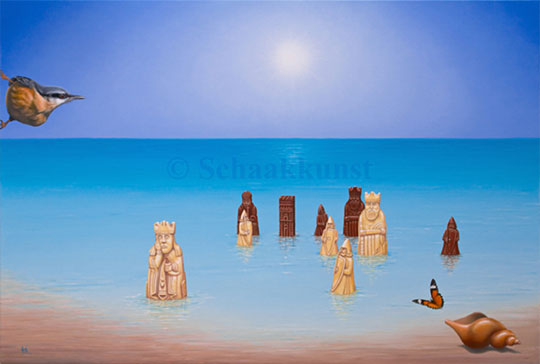
"The Power of Thought", 60x90 cm oil on canvas; 2014
The nuthatch on the left edge of the canvas tries to fathom the position. The butterfly, cethosia hypsea, comes out of its shell and gives assistance to the nuthatch. As in "The fait accompli" I made use of the Lewis chess set to shape the problem. A good example of the power and scope of the queen. In chess symbolism the queen stands for the mind and the king stands for the spirit. The position of the pieces represent the following problem:
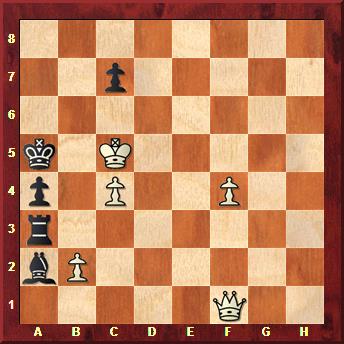
White to move mates in four moves! A brilliant problem.
In a higher sense this queen oversees all corners of the world (= the chessboard, here depicted as water, as in the collection of the Lewis Chessmen the board is missing) and therefore can easily find the solution: 1.Qh1 (threatens 2.Qa8 mate) 1...Rf3 (or 1…Bxc4 2.Qa8+ Ba6 3.bxa3 c6 4.Qd8 mate) 2.Qh8! (White would be too late after 2.Qxf3 Bxc4) 2...Bxc4 (the only defense) and now: 3.b4+ axb3 4.Qa1 mate. The most improbable mating move in this diagram.
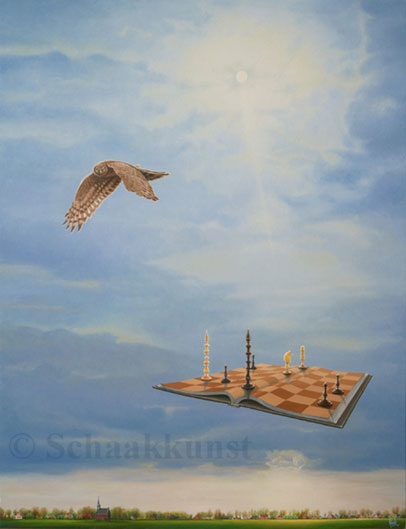
"The open book of Reti", 60x46 cm oil on panel; 2014
The beautiful chess studies of grandmaster Réti inspires me very much. This is a study from 1923 and it has a very unexpected course, the first move is in fact rook to e8! From a great height the hen harrier looks down on the study and assess its merits. Krommeniedijk, which where I have lived in the past, has such a beautiful silhouette that I wanted to paint it again, combined with a beautiful sky above the Klompenpad in Soest.
Richard Réti, Wiener Schachzeitung (v), 1923
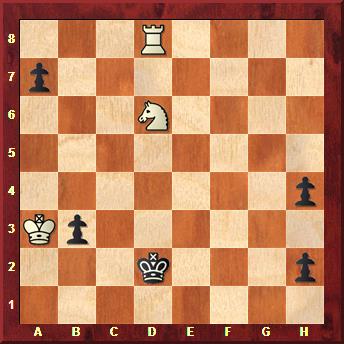
White to play and win! Solution: 1.Re8! h1Q [1...Kd1 2.Ne4] 2.Ne4+! Kc2 3.Rc8+ Kb1 4.Nd2+ Ka1 5.Nxb3+ Kb1 6.Nd2+ Ka1 7.Rc2 and mate to follow.
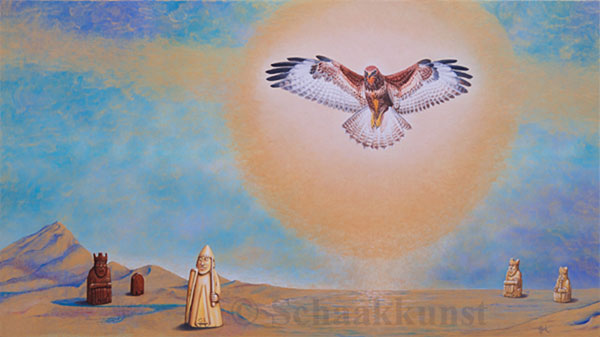
"The Golden Sun", 38x68 cm oil on panel; 2015
An experiment with gold paint, also inspired by a wonderful study of Réti. The Lewis Chessmen are correctly set up to represent the chess problem. In the golden sun there is an angel (a praying buzzard), which, from the spiritual world of high altitude, overlooks the spectacle and knows what is the winning move. The title was suggested to me by my grandsons Tion and Quinn, who insisted that the painting was to be called so. The Lewis Chessmen represent the following study:
Richard Réti, Bohemia 1923
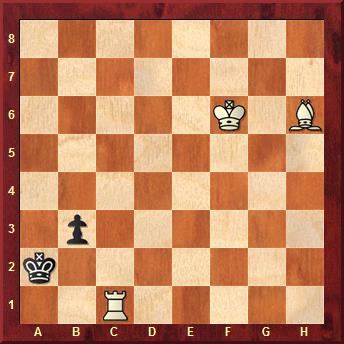
White to play and win. Solution: 1.Rc3 b2 2.Bc1 b1Q (pawn takes Bc1 or b1N is also a win for White) 3.Ra3#.

"The arrival of the Imperial Eagle", 50 x 100 cm oil on canvas; 2015
A wonderful composition, presented during the chess training of Ronald Staal of S.V. Leusden, inspired me to make this painting. Chess technically it is related to earlier themes from the schaakkuriosa series (see the book "Schaakkuriosa in kleur”). The imperial eagle plays with black and threatens to play pawn h1, with a promotion to queen, and achieves a win for Black. The kingfisher, a symbol of the goddess Alkyone, plays with white and, despite the threat, stays cool and plays, thanks to its insight into the spiritual world, almost casually the white king to the field h1, which blocks the black pawn. And then she can triumph, thanks to the remarkable position of the white knight. The imperial eagle is flying disappointed between the rooks, to enter the wide world on its way to other destinations. I used the tower of 'Doonagore Castle' in Ireland as a model for the rooks. This is the position:
Richard Réti, Hastings and St. Leonards Post 1922
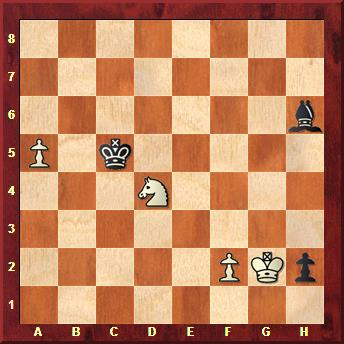
White to play and win. Solution: 1.Nd4+ Kc5 (position in the paining) 2.Kh1!! and e.g. 1...Bf4 2.Ne6+ Kb5 3.NxBf4 wins. Also on 1...Bg5 Bd2/Bc1/Bf8 follows Ne6+; or 1...KxNd4 2.a6 and White promotes to queen; or 1...Be3 2 fxBe3 etc.
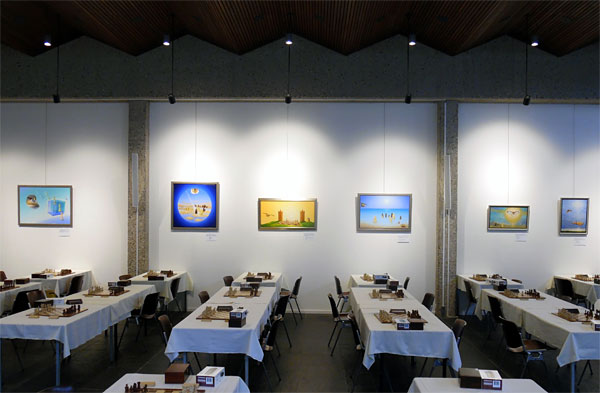
Six of Tjerk Zijlstra's paintings have a nice place in the main playing room in Hoogeveen
![]()
 |
Margreet herself makes (personalised) products for chess players from clubs, schools, etc. They are used, for example, as prizes, gifts, give aways and personal use. She uses many materials like paper, glass, metal, plastic, fabric and wood. With several printers (also 3D), heat press machines, cutters and so on, she can use a huge amount of techniques. |

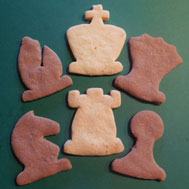
The most sold products by Schaakkunst are the scorebooks with personalised
design and handy ring binder.
The newest and also popular product is the "chess cookie cutter set".
Websites: www.schaakkunst.nl and www.chess-art.eu (webshop). Email: info@schaakkunst.nl
Previous ChessBase articles on Schaakkunst and Margreet Wevers